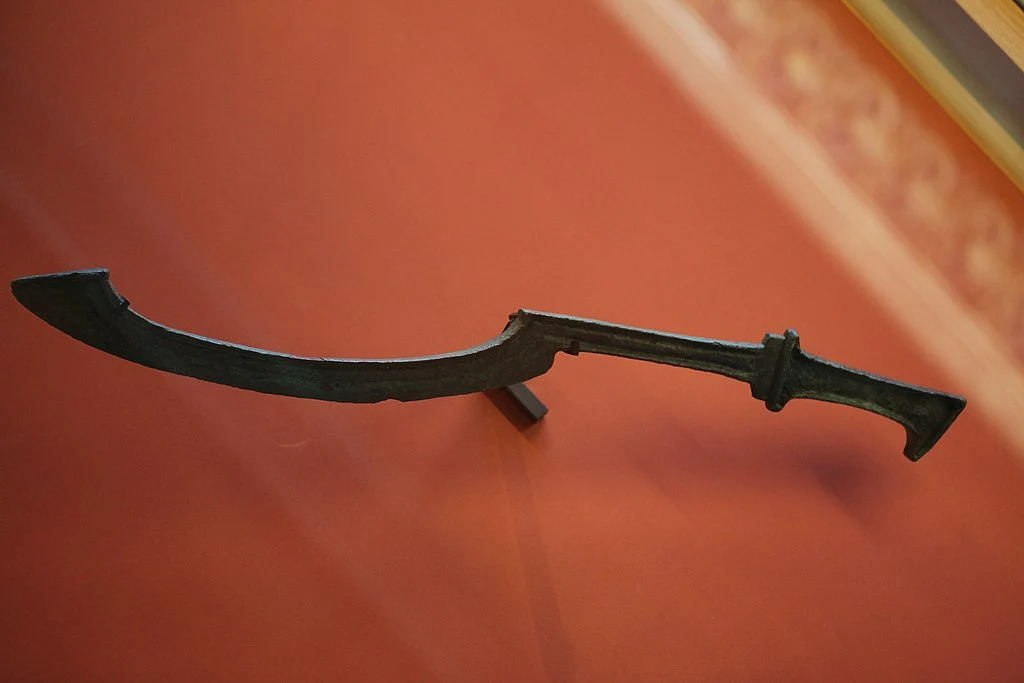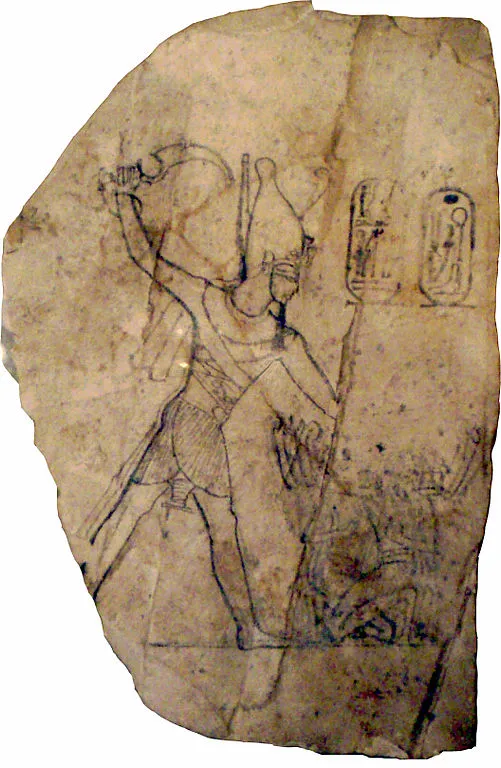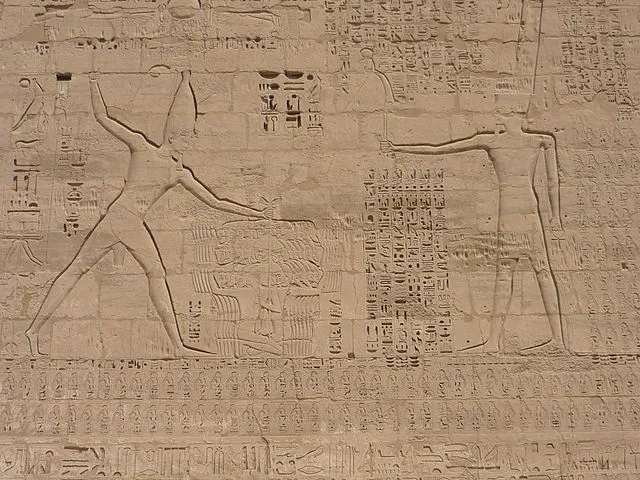Ancient Egypt’s influence on modern Western civilization is profound. Over centuries, Egypt has held a captivating spot in the Western consciousness, depicted as a land brimming with ancient wisdom, the Great Pyramids, and a bygone empire. Egyptian military technology helped them forge an empire that shaped ancient history. Among the most symbolic arms of ancient Egypt, the khopesh stands out.

The Khopesh is characterized by its uniquely curved blade designed for slashing and ensnaring foes’ shields. This weapon, a sword or saber, showcases a distinctive “U” or sickle shape (varying by era) with its sharpened edge on the convex portion. Originating in the ancient Near East and the Canaan region, the khopesh gained immense importance in Ancient Egypt, militarily, ritualistically, and symbolically.
Origins of The Ancient Egyptian Khopesh
The khopesh’s roots trace back to Sumer in the third millennium BC. Evolving from war axes, it’s distinct from typical swords as it slashes instead of producing deep cuts. Bronze casting advancements led to a fully metallic version, with weight reduced for blade proximity. This innovation aimed to replicate ax-cutting power in straight swords that were common at the time.
The khopesh was prevalent in Ancient Egypt alongside light war chariots and is believed to be a precursor to curved-blade war swords, akin to the earliest sabers. It gained prominence during the New Kingdom (1570–1070 BC) as a symbol of royal authority. Its legacy persisted through the Ptolemaic Dynasty, marking Egypt’s transition to Roman rule.
The Characteristics of The Khopesh Sword
The Khopesh is a unique weapon that bridges the characteristics of both battle axes and swords, featuring distinctive attributes that set it apart from other ancient weapons.
Type of Metal: The early khopesh was primarily made of bronze, with the blade and handle usually cast as a single piece. Over time, iron and steel versions replaced the original bronze designs. Today, modern khopesh replicas are crafted using materials like high-carbon steel and Damascus steel.
Blade Shape: The khopesh’s blade is straight for most of its length, curving dramatically towards the tip. Unlike the sickle’s concave edge, the khopesh boasts a convex cutting edge. This unique blade shape made it effective for slashing attacks, hooking an opponent’s shield, and ensnaring enemy weapons.
Size and Length: Typically formed from a single metal piece, the khopesh typically measured around 50 to 60 centimeters in total length. Some modern replicas exceed 60 centimeters, with a blade length of approximately 45 centimeters.
Handle and Sheath: The entire khopesh, including the handle and blade, was cast from one solid piece of metal, often bronze. Unlike wooden scabbards, contemporary reproductions often feature leather sheaths with belt loops and buttoned straps.
Evolution and Variations: The khopesh exhibited various variations over time. From concave-bladed versions to the more recognizable short saber-like designs, the weapon underwent centuries of development.
Generally, a khopesh measures around 50-60 cm in length, comprising three main components: an approximately 18 cm hilt, a straight edgeless section ranging from 15 to 30 cm, and a crescent-shaped end with a sharp outer edge spanning 30-40 cm.
Lacking hilt guards, the khopesh effectively countered the defensive armaments of its era, such as armor and shields. Its cutting power derived from its weight, accumulated at the point of impact, making it an early precursor to later saber designs.
Symbolic and Ceremonial Role Of The Ancient Egyptian Khopesh
The term “khopesh” derives from its resemblance to an animal’s foreleg, particularly an ox. Here’s what you should know about the Egyptian sickle sword: In ancient Egypt, the khopesh held significant symbolism of strength and royal authority.
Numerous Egyptian monarchs brandished the khopesh, linking the weapon to regal power and might. In a renowned depiction, Queen Nefertiti confronted a female captive with a khopesh in a striking scene. Moreover, Ramses II, or Ramesses, was the first pharaoh shown employing the Egyptian sickle sword in combat.

The Egyptian khopesh had ceremonial purposes too. In Hatshepsut’s mortuary temple at Deir el-Bahri, soldiers were portrayed wielding these swords. However, these Egyptian swords were likely wooden replicas rather than crafted from bronze, suggesting their role in ceremonial swordplay during pharaohs’ funeral rites. The khopesh also features symbolic portrayals like the dismemberment of enemy captives, a pharaoh leading a chariot into battle, and acts of smiting.
The Egyptian Khopesh Sword in History
Egypt’s military history was marked by the assimilation of innovative warfare tactics from neighboring civilizations, notably adopting the khopesh sword. By the New Kingdom era, this weapon had become an emblem of Egyptian might. The transition from stone to metal tools during the Bronze Age revolutionized combat strategies.

Around 3000 BCE, unalloyed copper swords emerged, succeeded by sickle swords, an antecedent to the khopesh, in Chaldea. The evolution continued with the development of bronze through alloying copper with arsenic and later tin, resulting in a malleable and durable material. In the Middle Kingdom, Egypt’s military prowess was showcased through specialized weaponry, fortresses, and sieges.
The Second Intermediate Period saw the rise of the Hyksos, who introduced the khopesh and chariots to Egyptian warfare while advancing bronze casting methods. The New Kingdom was a pinnacle of Egyptian power, with the khopesh serving as a pivotal close-quarters weapon during this period. Tutankhamun’s tomb contained various khopeshes, implying diverse battlefield functions. The smaller variant excelled at slashing, while the larger type focused on crushing.
The Battle of Kadesh, in 1275 BCE, pitted the Egyptian pharaoh Ramses II against the Hittite army. Employing khopeshes and composite bows, Egypt tactically triumphed, but the Hittites emerged as the ultimate victors, gaining control over the Levant. Throughout these epochs, Egypt’s military evolution, underscored by the khopesh, mirrored its dynamic interactions with neighboring cultures, shaping its combat prowess and strategic advances.
Also Read: Trebuchet vs Catapult: Which Mighty War Machine is Better?
